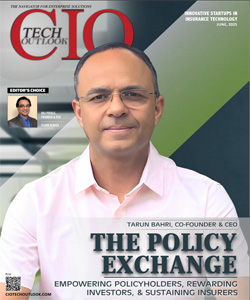How Autonomous Systems Are Redefining IT Governance
Janifha Evangeline, Assistant Editor, CIOTechOutlook | Sunday, 09 February 2025, 19:19 IST
 In IDC’s April 2024 CIO Poll Survey of 105 senior IT professionals and CIOs, “developing better IT governance and enterprise architecture” emerged as one of the top priorities for 2024, ranking fourth. While different needs including integrating an emphasis on Artificial intelligence into the IT methodology, working on the way to deal with programming obtaining and sending, and building better IT abilities and capabilities are positioned higher in the overview, IT administration is substantially more basic. Without well-working IT administration, how might you advance on contending needs? It is key for simulated intelligence and fundamental for decreasing network safety gambles or smoothing out cloud relocation processes, in addition to other things.
In IDC’s April 2024 CIO Poll Survey of 105 senior IT professionals and CIOs, “developing better IT governance and enterprise architecture” emerged as one of the top priorities for 2024, ranking fourth. While different needs including integrating an emphasis on Artificial intelligence into the IT methodology, working on the way to deal with programming obtaining and sending, and building better IT abilities and capabilities are positioned higher in the overview, IT administration is substantially more basic. Without well-working IT administration, how might you advance on contending needs? It is key for simulated intelligence and fundamental for decreasing network safety gambles or smoothing out cloud relocation processes, in addition to other things.
The rapid advancement of AI as well as machine learning has prepared the way for autonomous systems to play a major role in IT governance. As industries and businesses start to embrace digital transformation, IT governance is no longer only about policy enforcement as well as compliance but also about enabling agility, resilience and proactive risk management. In this article let us look at how autonomous systems are redefining IT governance.
Enhancing Compliance and Risk Management
“AI and automation are two of the most powerful tools helping audit, risk and compliance teams close the risk resiliency gap,” said Rich Marcus, chief information security officer at AuditBoard.
One of the key advantages of autonomous systems in IT governance is their ability of streamlining compliance and risk management. Regulatory compliance is one of the major concerns for companies, particularly in highly regulated sectors which include finance, healthcare, & telecommunications. Ensuring compliance with standards like GDPR, HIPAA, and ISO 27001 customarily requires extensive manual oversight, reporting, and audits.
“Companies are under increasing pressure to manage a complex web of governance, risk and compliance demands as the scope and complexity of Governance, risk and compliance grows. To respond to these evolving expectations, proactive companies are embracing automation, which can boost efficiency, reduce risks and help them fully realize the promises of GRC,” says Adam Markowitz, Cofounder and CEO.
Strengthening cybersecurity with intelligent automation
“Organizations can no longer afford not to implement AI-powered automation tools to optimize efficiency,” said Edward Amoroso, founder and CEO of TAG Cyber.
Cybersecurity threats are developing at an unprecedented speed, and traditional security measures often struggle to keep up. Autonomous cybersecurity systems offer a game-changing approach for IT governance by detecting, responding to, and mitigating cyber threats in real-time. These systems utilize ML algorithms for analyzing patterns of behavior, detect anomalies, as well as automatically neutralize potential threats before they cause damage.
“The future of threat detection and response must keep up with the speed and sophistication of adversaries and the realities facing today’s already overstretched SOC teams,” said Ric Smith, President, Product, Technology, and Operations at SentinelOne.
Optimizing IT Operations and Decision Making
“Addressing IT efficiency should be an ongoing process, not a one-time event, says Robert Orshaw, global cloud operate leader with Deloitte Consulting. Continuous improvement is key, he notes.
“The progressive companies we support leverage AI and ML technologies to automate routine tasks, predict and identify potential issues before they occur, and provide data-driven insights that accelerate both delivery capacity and decision-making, driving a significant efficiency lift to many organizations’ operations,” says Robert Orshaw, global cloud operate leader with Deloitte Consulting.
IT operations have traditionally relied on manual oversight and human decision making, which can be tedious and prone to blunders. Autonomous systems introduce a new paradigm where decision making is data driven, automated and continuously optimized. IT service management platforms that are powered by Artificial Intelligence can manage IT resources autonomously, optimize cloud infrastructure and ensure seamless system performance with minimal human intervention.
“IT admins play a pivotal role in this journey, acting as the architects of innovation and the guardians of data integrity. By leveraging the rich set of governance tools, they can manage sharing and data extensibility, gain visibility into usage patterns, and enforce robust governance strategies. This level of control fosters a secure and compliant environment, allowing organizations to fully embrace the transformative potential of generative AI,” says Ryan Jones, Partner Director of Product Management, Power Apps, Microsoft.
“As we look to the future, the possibilities are boundless. With the right governance in place, organizations can unlock new levels of productivity, creativity, and efficiency,” he adds.
Autonomous systems are generally reshaping IT governance by presenting AI-driven Automation, enhancing compliance, strengthening cybersecurity, and optimizing decision making. Firms that integrate these technologies into their IT government frameworks will be better prepared to navigate the complexities of the digital age. While challenges, for example, ethical considerations and system integration remain, the long-term benefits of autonomous IT governance far outweigh the obstacles. By utilizing artificial intelligence and automation, businesses can build resilient, compliant, and future-ready IT ecosystems that drive innovation and sustainable growth.




